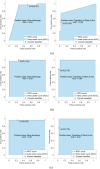Modeling and optimization of argon-based floating helix electrode cold plasma
- PMID: 41023205
- PMCID: PMC12479843
- DOI: 10.1038/s41598-025-18837-7
Modeling and optimization of argon-based floating helix electrode cold plasma
Abstract
Cold atmospheric pressure plasma (CAP) technology has vast potential in several technological domains, including biomedical engineering. CAP, also known as non-thermal plasma, is characterized by high-energy electrons while the bulk gas remains near room temperature, allowing for effective plasma treatment without thermal damage-critical for biomedical applications. This paper presents a coupled machine learning and statistical technique-based process modeling and optimization approach for a novel floating-helix electrode-based cold plasma device, operating strictly within the cold plasma regime. An artificial neural network (ANN) model was developed to describe the relationship between the process parameters-supply voltage (SV) and frequency (SF)-and performance parameters-power consumption (P), and jet lengths with and without an end ring (JwER and JwoER). The generality and robustness of the ANN model were confirmed through experimental validation and extrapolative predictions. For multi-response optimization, the composite desirability method was employed. Finally, machine learning models for logistic regression-namely, ANN classifier, K-Nearest Neighbor, and Support Vector Machine-were developed to classify the discharge type within the cold plasma operating range, ensuring its suitability for biomedical applications. The proposed system may hold potential for biomedical use, contingent upon further validation through biological testing.
Keywords: Argon; Biomedical devices; Cold plasma; Machine learning.
© 2025. The Author(s).
Conflict of interest statement
Declarations. Competing interests: The authors declare no competing interests.
Figures
















References
-
- Eliasson, B. & Kogelschatz, U. Modeling and applications of silent discharge plasmas. IEEE Trans. Plasma Sci.19 (2), 309–323 (1991).
-
- Gibalov, V. I. & Pietsch, G. J. The development of dielectric barrier discharges in gas gaps and on surfaces. J. Phys. D. 33 (20), 2618 (2000).
-
- Ekezie, F. G. C., Sun, D. W. & Cheng, J. H. A review on recent advances in cold plasma technology for the food industry: current applications and future trends. Trends Food Sci. Technol.69, 46–58 (2017).
-
- Chen, Z. et al. Cold atmospheric plasma delivery for biomedical applications. Mater. Today. 54, 153–188 (2022).
-
- Radu, I., Bartnikas, R., Czeremuszkin, G. & Wertheimer, M. R. Diagnostics of dielectric barrier discharges in noble gases: atmospheric pressure glow and pseudoglow discharges and spatio-temporal patterns. IEEE Trans. Plasma Sci.31 (3), 411–421 (2003).
LinkOut - more resources
Full Text Sources
Miscellaneous

